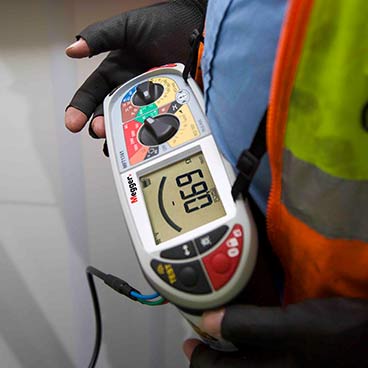The new electrical testing Regulations 2020 for landlords require landlords to have the electrical installations in their properties inspected and tested by a person who is qualified and competent, at least every 5 years. Landlords have to provide a copy of the electrical safety report to their tenants, and to their local authority if requested.
This means that all landlords now have to do what good landlords already do: make sure the electrical installations in their rented properties are safe.
The Regulations come into force on 1st June 2020 and form part of the Department’s wider work to improve safety in all residential premises and particularly in the private rented sector.
This is a major step towards levelling up the private rented sector, making sure it will offer high-quality, safe and secure housing. Along with our social and owner-occupied sectors, this is housing this country deserves.
We value the contribution made by good landlords, the majority of whom provide well maintained, safe, secure and high-quality places to live, work and raise families.
ELECTRICAL TESTS FROM £200.00
EICR domestic testing starts at £200.00 up to a maximum of 10 circuits for one consumer unit (DB1).
Any additional circuits within DB1 charged at £10.00 each.
Any additional consumer units charged at £75.00 + £10 per circuit
All prices shown are + VAT

Electrical Safety Standards Requirements
Electrical safety standards in the private sector (England) regulations 2020 require:
Landlords of privately rented accommodation must:
- Ensure national standards for electrical safety are met. These are set out in the 18th edition of the ‘Wiring Regulations’, which are published as British Standard 7671.
- Ensure the electrical installations in their rented properties are inspected and tested by a qualified and competent person at least every 5 years.
- Obtain a report from the person conducting the inspection and test which gives the results and sets a date for the next inspection and test.
- Supply a copy of this report to the existing tenant within 28 days of the inspection and test.
- Supply a copy of this report to a new tenant before they occupy the premises.
- Supply a copy of this report to any prospective tenant within 28 days of receiving a request for the report.
- Supply the local authority with a copy of this report within 7 days of receiving a request for a copy.
- Retain a copy of the report to give to the inspector and tester who will undertake the next inspection and test.
- Where the report shows that remedial or further investigative work is necessary, complete this work within 28 days or any shorter period if specified as necessary in the report.
- Supply written confirmation of the completion of the remedial works from the electrician to the tenant and the local authority within 28 days of completion of the works.
The Regulations apply to:
The Regulations apply to new tenancies from 1 July 2020 and existing tenancies from 1 April 2021.
If a private tenant has a right to occupy a property as their only or main residence and pays rent, then the Regulations apply. This includes assured shorthold tenancies and licences to occupy.
Houses of multiple Occupation (HMO)
A house in multiple occupation (HMO) is a property rented out by at least 3 people who are not from one ‘household’ (for example a family) but share facilities like the bathroom and kitchen. If an HMO is a tenant’s only or main residence and they pay rent, then these Regulations apply to the HMO.
The Management of Houses in Multiple Occupation (England) Regulations 2006 previously put specific duties on landlords around electrical safety. This requirement has now been repealed, and HMOs are now covered by the new Electrical Safety Regulations.
HMOs with 5 or more tenants are licensable. The Housing Act 2004 has been amended by these Regulations to require a new mandatory condition in HMO licences ensuring that every electrical installation in the HMO is in proper working order and safe for continued use.

Inspection
The Regulations require landlords to have the electrical installations in their properties inspected and tested by a person who is qualified and competent, at least every 5 years.
Guidance has been produced by the electrical safety industry that covers how landlords can choose a qualified and competent inspector and tester.
The electrical safety industry has established competent person schemes. Membership of these will not be compulsory to ensure there is no further pressure placed on the industry, nor undue burden placed on inspectors and testers.
When commissioning an inspection, in order to establish if a person is qualified and competent landlords can:
- check if the inspector is a member of a competent person scheme; or
- require the inspector to sign a checklist certifying their competence, including their experience, whether they have adequate insurance and hold a qualification covering the current version of the Wiring Regulations and the periodic inspection, testing and certification of electrical installations.
The standards that should be met:
The standards that should be met are set out in the 18th edition of the Wiring Regulations.
The Regulations state that a landlord must ensure that electrical safety standards are met, and that investigative or remedial work is carried out if the report requires this.
The electrical installation should be safe for continued use. In practice, if the report does not require investigative or remedial work, the landlord will not be required to carry out any further work.
What will be tested?
The ‘fixed’ electrical parts of the property, like the wiring, the socket-outlets (plug sockets), the light fittings and the consumer unit (or fuse box) outbuildings and exterior power will be inspected. This will include permanently connected equipment such as showers, extractor fans and smoke alarms.
What will happen in the inspection?
The inspection will find out if:
- any electrical installations are overloaded
- there are any potential electric shock risks and fire hazards
- there is any defective electrical work
- there is a lack of earthing or bonding – these are 2 ways of preventing electrical shocks that are built into electrical installations
What about electrical appliances like cookers, fridges, televisions etc?
The Regulations do not cover electrical appliances, only the fixed electrical installations.
We recommend that landlords regularly carry out portable appliance testing (PAT) on any electrical appliance that they provide and then supply tenants with a record of any electrical inspections carried out as good practice.
Tenants are responsible for making sure that any of their own electrical appliances are safe.
Tenants and landlords may consider registering their own electrical appliances with a product registration scheme.
The report
Landlords must obtain a report (usually an Electrical Installation Condition Report or EICR) from the person conducting the inspection and test which explains its outcomes and any investigative or remedial work required.
Landlords must then supply a copy of this report to the tenant within 28 days of the inspection and test, to a new tenant before they occupy the premises, and to any prospective tenant within 28 days of receiving a request for the report.
If a local authority requests it, landlords must supply them with a copy of this report within 7 days of receiving the request.
If the report requires remedial work or further investigation, landlords must provide written confirmation that the work has been carried out to their tenant and to the local authority within 28 days of completing the work.
Landlords must retain a copy of the report to give to the inspector and tester who will undertake the next inspection and test.

What will the report show?
The electrical installation should be safe for continued use. In practice, if the report does not require investigative or remedial work, the landlord will not be required to carry out any further work.
Inspectors will use the following classification codes to indicate where a landlord must undertake remedial work.
- Code 1 (C1): Danger present. Risk of injury. The electrical inspector may make any C1 hazards safe before leaving the property.
- Code 2 (C2): Potentially dangerous.
- Further Investigation (FI): Further investigation required without delay.
- Code 3 (C3): Improvement recommended. Further remedial work is not required for the report to be deemed satisfactory.
If codes C1 or C2 are identified in on the report, then remedial work will be required. The report will state the installation is unsatisfactory for continued use.
If an inspector identifies that further investigative work is required (FI), the landlord must also ensure this is carried out.
The C3 classification code does not indicate remedial work is required, but only that improvement is recommended. Landlords don’t have to make the improvement, but it would improve the safety of the installation if they did.
Remedial work
If the report shows that remedial work or further investigation is required, as set out above, landlords must complete this work within 28 days or any shorter period if specified as necessary in the report. Landlords must then provide written confirmation that the work has been carried out to their tenant and to the local authority within 28 days.
What if I don’t do the remedial work?
If a local authority has reasonable grounds to believe that a landlord is in breach of one or more of the duties in the Regulations, they must serve a remedial notice on the landlord requiring remedial action.
Should a landlord not comply with the notice, the local authority may arrange for remedial action to be taken themselves.
The local authority can recover the costs of taking the action from the landlord. The landlord has the right of appeal against a demand for costs.
Urgent remedial action
If the report indicates that urgent remedial action is required, and the landlord has not carried this out within the period specified in the report, the local authority may with the consent of the tenant arrange to carry out remedial work.
The local authority must authorise a qualified and competent person in writing to undertake the remedial action and give at least 48 hours’ notice to the tenant.
The costs for carrying out the remedial work can be recovered from the landlord.
Financial penalties
Local authorities may impose a financial penalty of up to £30,000 on landlords who are in breach of their duties.










